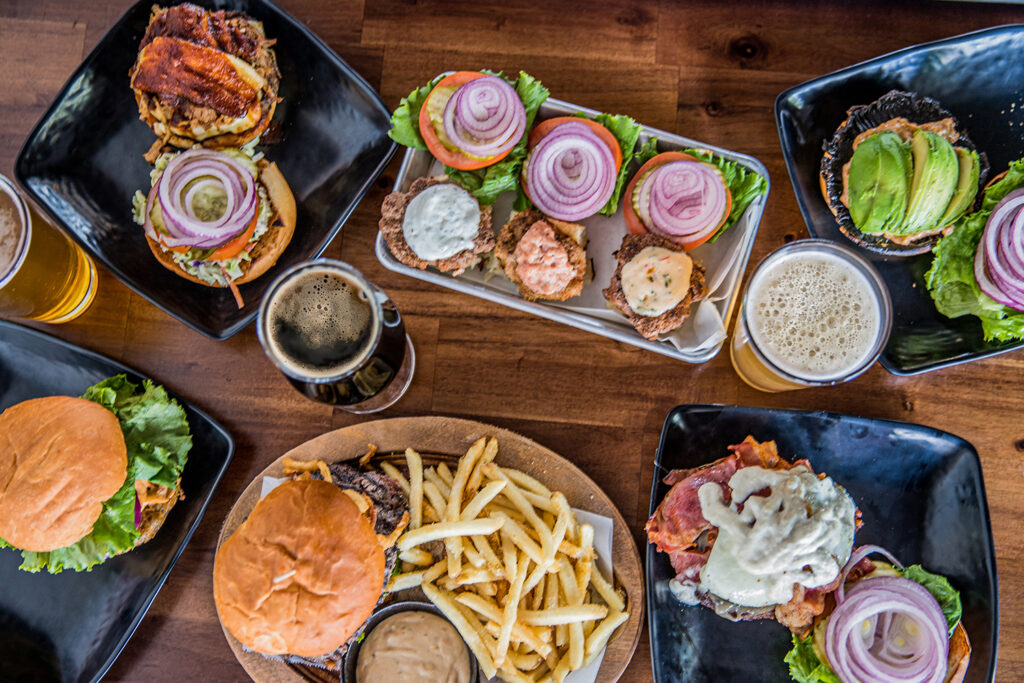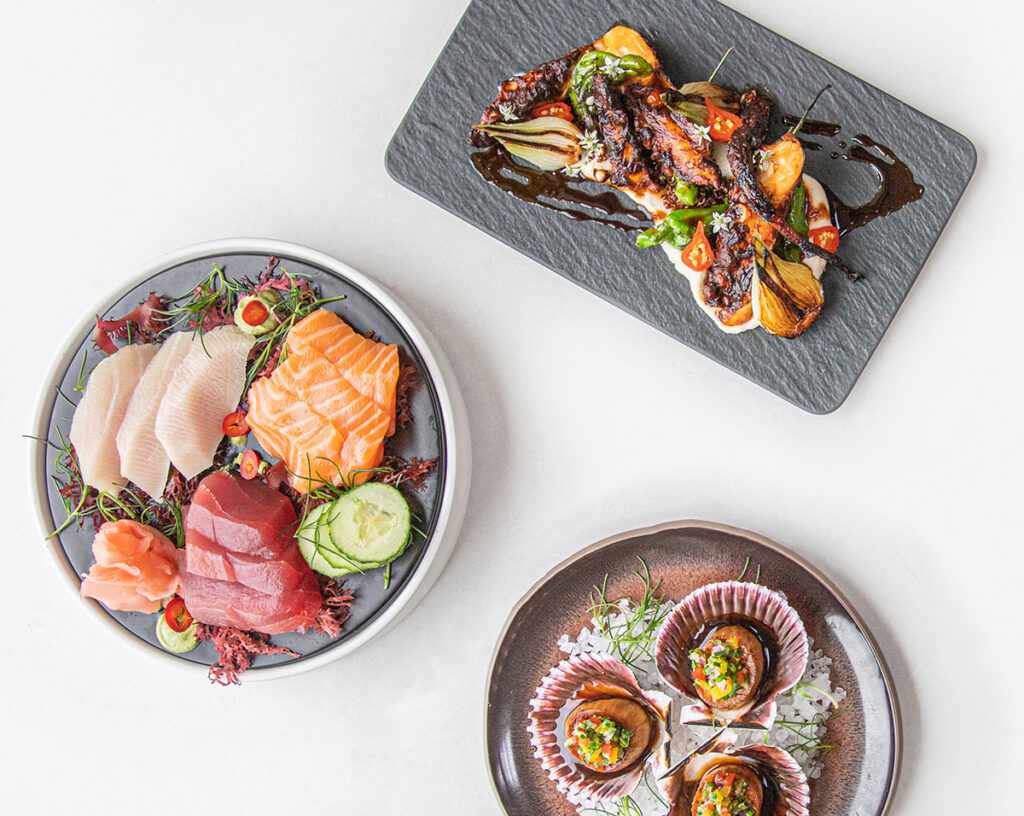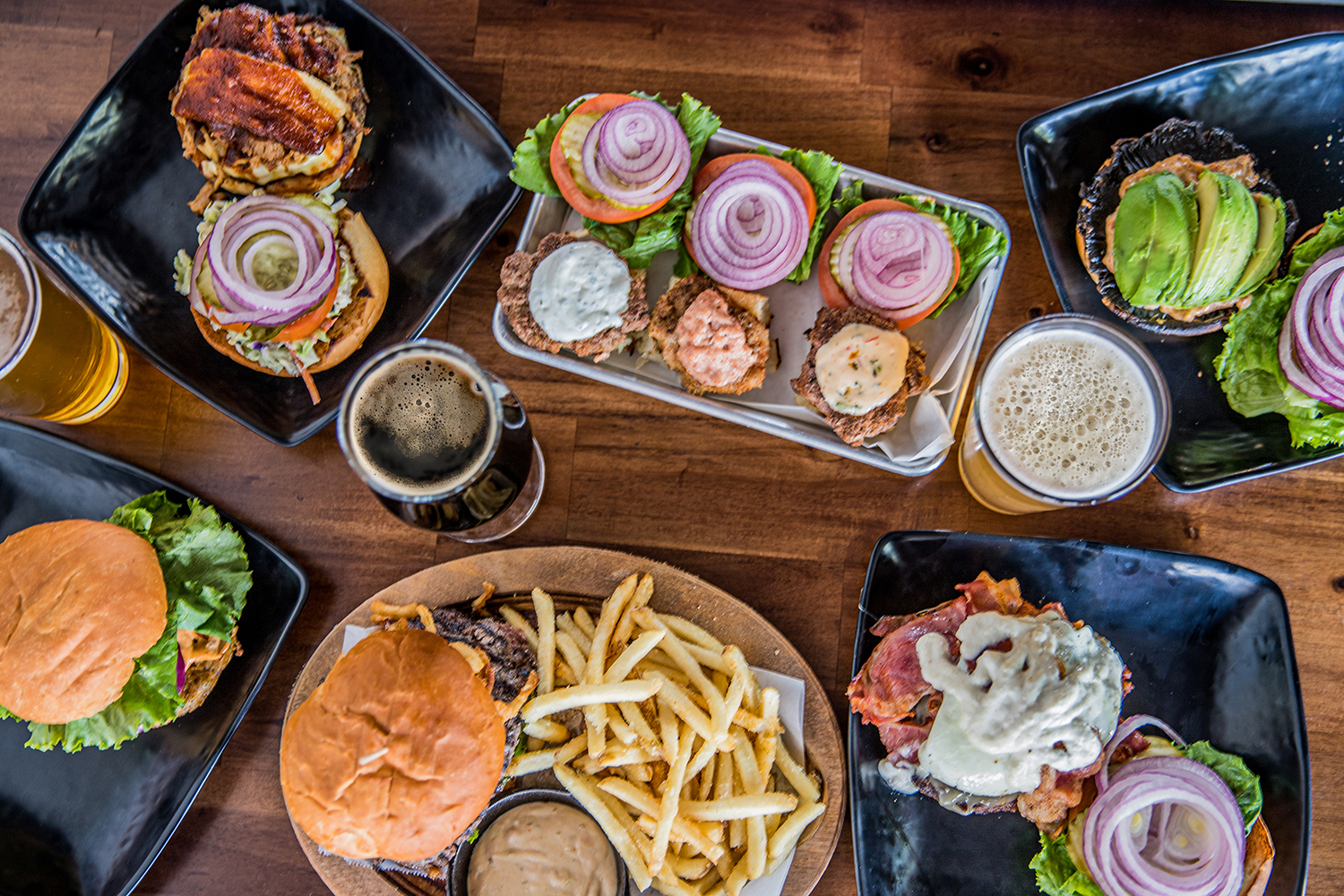Variety is the spice of life — and it can make your food photography come to life as well! In this post from my Restaurant Photography Must-Haves series, we’ll dive into how using a mix of shapes in your shots can add depth, interest, and excitement to your images with intentional restaurant photography styling.
When you think about food photography for your restaurant, it’s easy to default to classic shapes — round plates, circular bowls, or perfectly stacked burgers. But when it comes to composition, it’s important to break free from uniformity. This is particularly important for overhead or top-down, flat lay shots. A variety of shapes can introduce visual variety, enhancing the storytelling of your images and helping your dishes stand out from the crowd. There is a point when repetition can be boring, for example, an overhead flatlay shot of a round burger on a round plate with the circular overhead of a drink. By mixing up the shapes of either the food or the plates, you’ll get a compositionally more interesting image.

Why a Mix of Shapes is Essential in Restaurant Photography
- Enhances Visual Interest: If all the plates and bowls in your photos are the same shape, your shots can look flat and predictable. Introducing contrasting shapes can make the composition more dynamic and visually engaging.
- Improves Balance and Harmony: Combining various shapes, such as round, square, and triangular, helps create a balanced layout while maintaining harmony. This can make the food look more visually appealing and even guide the viewer’s eye around the image.
- Adds a Sense of Fun: A mix of shapes can convey playfulness and creativity in your food photography. Unusual pairings—like a round dish on a square plate or layered elements with contrasting angles—draw the eye and keep viewers engaged without feeling overly staged.Shows the Variety of Your Menu: Your menu spans more than just flavors — it includes a mix of food types, meal times, and courses. Being intentional with plate shapes while showcasing that diversity helps reinforce just how much your restaurant has to offer. A dish served on a square plate and another on a circular one signals that you offer a range of unique options, reinforcing that your menu is diverse and has a broader range of appeal.
How to Use a Mix of Shapes in Your Restaurant Photography
✔ Play with Plate and Bowl Shapes: Try not to use only round plates and bowls. Introduce square, rectangular, or even asymmetrical plates into your shoot to add diversity. For example, serve a classic burger on a rectangular plate or a side salad in a square bowl.
✔ Pair Complementary Shapes: When stacking or arranging food, mix up the shapes thoughtfully. For instance, a slice of cake on a round plate can pair beautifully with a rectangular dessert spoon or a triangular wedge of pizza on a square plate. The key is finding balance and complementary contrasts.
✔ Use Flatware to Introduce Shapes: Flatware isn’t just functional — it’s a subtle but powerful tool for adding visual interest through shape. Long, narrow utensils like forks, knives, or chopsticks introduce clean rectangular lines that contrast beautifully with the curves of round plates or soft food textures. Even the humble soup spoon, with its rounded bowl, can echo and enhance circular elements in a composition. Pair these with square or folded napkins and angular serving trays to layer in geometric variety and guide the viewer’s eye across the frame. Used thoughtfully, these supporting elements help create balance, texture, and rhythm within your scene — all without distracting from the food.
✔ Add Layers with Shape Variations: Layering foods with different shapes adds depth, contrast, and visual texture to your images. Placing a round item next to something angular—like a round burger next to a serving of fries, which often reads as a pile of rectanlges—creates a dynamic composition that draws the eye. That said, it’s perfectly okay to occasionally use a round plate for a round object; just be mindful of how the overall layout balances variety and harmony. These subtle contrasts create dimension and keep your food photography visually engaging.

Restaurant Photography Styling Tip: Mix It Up
A mix of shapes in your food photography helps avoid the monotony of uniformity and creates a more dynamic, engaging visual experience. As a restaurant photographer, I’m always paying attention to how styling choices shape the overall scene. Mixing forms—rounds, rectangles, and irregular edges—is one of my go-to restaurant photography styling tips for making food pop naturally. It encourages the viewer’s eye to move around the frame and appreciate the diversity of your dishes, which can make your restaurant’s food look even more enticing.
The next time you set up your food shoot, think beyond the standard round plate or bowl. Introduce a little variety with a playful mix of shapes, and watch how it transforms the mood and style of your photos.
Ready to add some shape variety to your food photos?
Contact me today to elevate your restaurant’s visual storytelling with creative, shape-driven food photography that highlights your dishes in the best light. I even have a prop stash with the mix of shapes I mentioned, so let’s try some different shapes on your dishes.
More Restaurant Photography Must-Have Shots
You’ve seen how playing with shapes can elevate your restaurant photography — next, we’ll explore how textures bring your dishes to life. From crispy edges to creamy sauces, texture adds depth, contrast, and irresistible appeal. Stay tuned for the next post in the Restaurant Photography Must-Haves series.
In case you’re new to this series, you can jump back to Part One: Must-Have Shots for Restaurant Photography here.

leave a comment